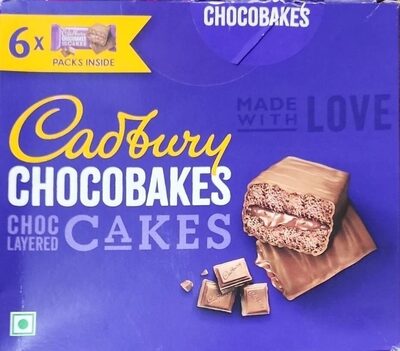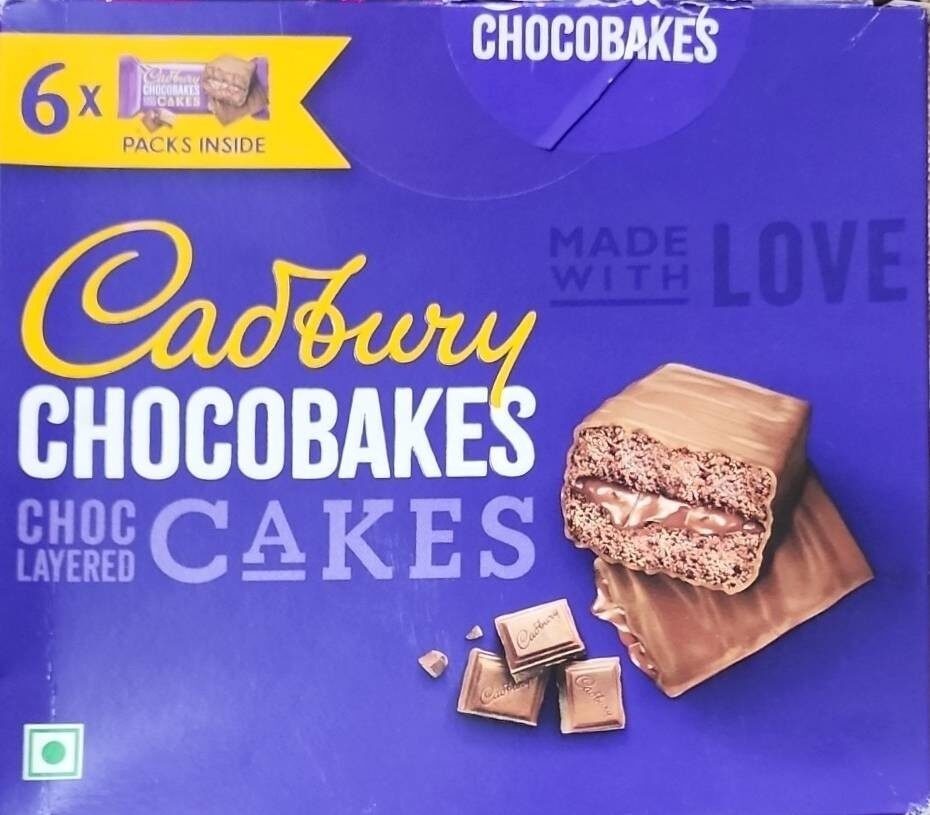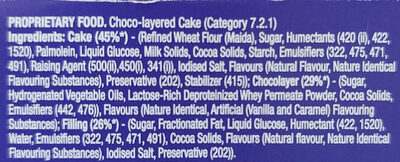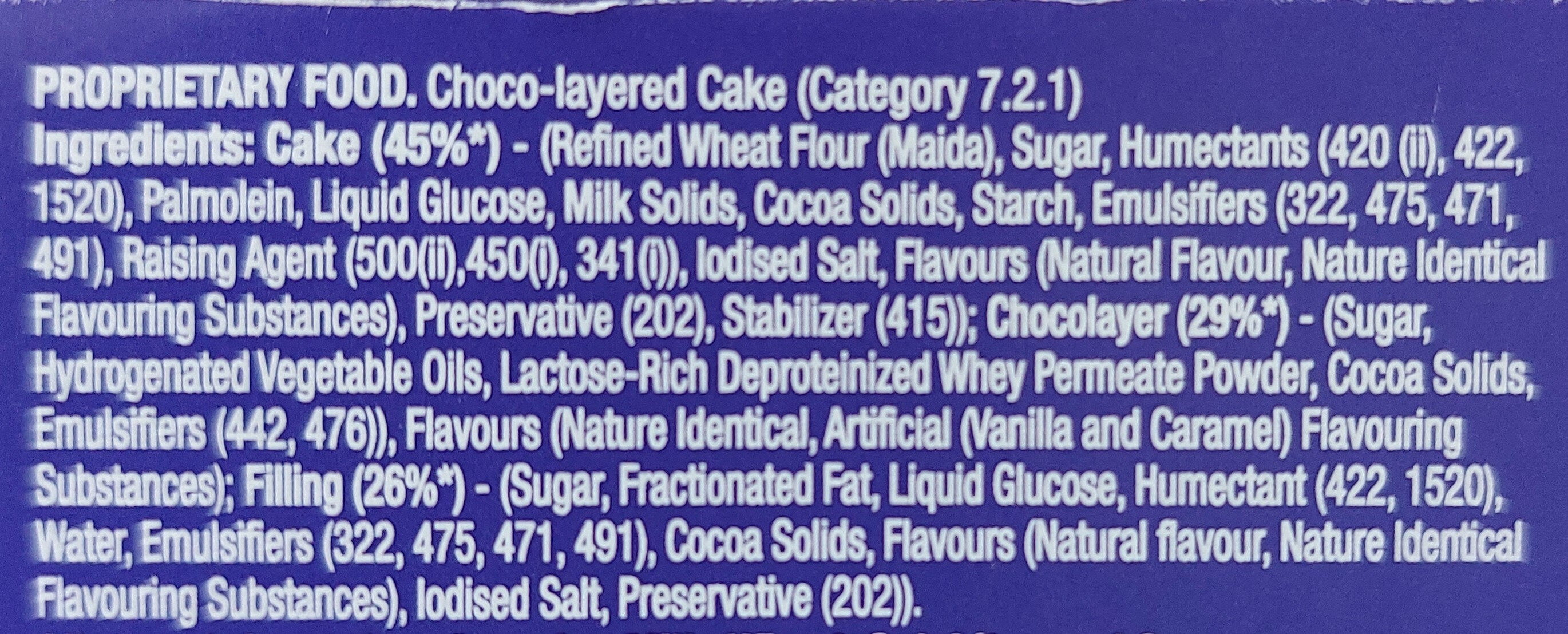Help us make food transparency the norm!
As a non-profit organization, we depend on your donations to continue informing consumers around the world about what they eat.
The food revolution starts with you!
Chocobakes - Cadbury - 126 g
Chocobakes - Cadbury - 126 g
This product page is not complete. You can help to complete it by editing it and adding more data from the photos we have, or by taking more photos using the app for Android or iPhone/iPad. Thank you!
×
Barcode: 7622201442828 (EAN / EAN-13)
Common name: Chocolate cake
Quantity: 126 g
Packaging: Cardboard box
Brands: Cadbury
Categories: Snacks, Sweet snacks, Biscuits and cakes, Cakes, Chocolate cakes
Labels, certifications, awards:
Vegetarian, Green Dot India
Origin of the product and/or its ingredients: India
Origin of ingredients: India
Countries where sold: India
Matching with your preferences
Health
Ingredients
-
67 ingredients
Cake (45%*) - (Refined Wheat Flour (Maida), Sugar, Humectants (420 (ii), 422, 1520), Palmolein, Liquid Glucose, Milk Solids, Cocoa Solids, Starch, Emulsifiers (322, 475, 471, 491), Raising Agent (500(i),450(1), 341()), lodised Salt, Flavours (Natural Flavour, Nature Identical Flavouring Substances), Preservative (202), Stabilizer (415)); Chocolayer (29%*)-(Sugar, Hydrogenated Vegetable Oils, Lactose-Rich Deproteinized Whey Permeate Powder, Cocoa Solids, Emulsifiers (442, 476)), Flavours (Nature Identical, Artificial (Vanilla and Caramel) Flavouring Substances); Filling (26%*) - (Sugar, Fractionated Fat, Liquid Glucose, Humectant (422, 1520), Water, Emulsifiers (322, 475, 471, 491), Cocoa Solids, Flavours (Natural flavour, Nature Identical Flavouring Substances), lodised Salt, Preservative (202)).Allergens: GlutenTraces: Gluten, Milk, Soybeans, Sulphur dioxide and sulphites
Food processing
-
Ultra processed foods
Elements that indicate the product is in the 4 - Ultra processed food and drink products group:
- Additive: E322 - Lecithins
- Additive: E415 - Xanthan gum
- Additive: E420 - Sorbitol
- Additive: E422 - Glycerol
- Additive: E442 - Ammonium phosphatides
- Additive: E450 - Diphosphates
- Additive: E471 - Mono- and diglycerides of fatty acids
- Additive: E475 - Polyglycerol esters of fatty acids
- Additive: E476 - Polyglycerol polyricinoleate
- Additive: E491 - Sorbitan monostearate
- Ingredient: Emulsifier
- Ingredient: Flavouring
- Ingredient: Glucose
- Ingredient: Humectant
- Ingredient: Hydrogenated oil
Food products are classified into 4 groups according to their degree of processing:
- Unprocessed or minimally processed foods
- Processed culinary ingredients
- Processed foods
- Ultra processed foods
The determination of the group is based on the category of the product and on the ingredients it contains.
Additives
-
E202 - Potassium sorbate
Potassium sorbate (E202) is a synthetic food preservative commonly used to extend the shelf life of various food products.
It works by inhibiting the growth of molds, yeast, and some bacteria, preventing spoilage. When added to foods, it helps maintain their freshness and quality.
Some studies have shown that when combined with nitrites, potassium sorbate have genotoxic activity in vitro. However, potassium sorbate is generally recognized as safe (GRAS) by regulatory authorities.
-
E322 - Lecithins
Lecithins are natural compounds commonly used in the food industry as emulsifiers and stabilizers.
Extracted from sources like soybeans and eggs, lecithins consist of phospholipids that enhance the mixing of oil and water, ensuring smooth textures in various products like chocolates, dressings, and baked goods.
They do not present any known health risks.
-
E341 - Calcium phosphates
Calcium phosphate: Calcium phosphate is a family of materials and minerals containing calcium ions -Ca2+- together with inorganic phosphate anions. Some so-called calcium phosphates contain oxide and hydroxide as well. They are white solids of nutritious value.Source: Wikipedia
-
E415 - Xanthan gum
Xanthan gum (E415) is a natural polysaccharide derived from fermented sugars, often used in the food industry as a thickening and stabilizing agent.
This versatile food additive enhances texture and prevents ingredient separation in a wide range of products, including salad dressings, sauces, and gluten-free baked goods.
It is considered safe for consumption even at high intake amounts.
-
E420 - Sorbitol
Sorbitol: Sorbitol --, less commonly known as glucitol --, is a sugar alcohol with a sweet taste which the human body metabolizes slowly. It can be obtained by reduction of glucose, which changes the aldehyde group to a hydroxyl group. Most sorbitol is made from corn syrup, but it is also found in nature, for example in apples, pears, peaches, and prunes. It is converted to fructose by sorbitol-6-phosphate 2-dehydrogenase. Sorbitol is an isomer of mannitol, another sugar alcohol; the two differ only in the orientation of the hydroxyl group on carbon 2. While similar, the two sugar alcohols have very different sources in nature, melting points, and uses.Source: Wikipedia
-
E422 - Glycerol
Glycerol: Glycerol -; also called glycerine or glycerin; see spelling differences- is a simple polyol compound. It is a colorless, odorless, viscous liquid that is sweet-tasting and non-toxic. The glycerol backbone is found in all lipids known as triglycerides. It is widely used in the food industry as a sweetener and humectant and in pharmaceutical formulations. Glycerol has three hydroxyl groups that are responsible for its solubility in water and its hygroscopic nature.Source: Wikipedia
-
E442 - Ammonium phosphatides
Mixed ammonium salts of phosphorylated glycerides: The mix of ammonium salts of phosphorylated glycerides can be either made synthetically or from mixture of glycerol and partially hardened plant -most often used: rapeseed oil- oils.Source: Wikipedia
-
E450 - Diphosphates
Diphosphates (E450) are food additives often utilized to modify the texture of products, acting as leavening agents in baking and preventing the coagulation of canned food.
These salts can stabilize whipped cream and are also found in powdered products to maintain their flow properties. They are commonly present in baked goods, processed meats, and soft drinks.
Derived from phosphoric acid, they're part of our daily phosphate intake, which often surpasses recommended levels due to the prevalence of phosphates in processed foods and drinks.
Excessive phosphate consumption is linked to health issues, such as impaired kidney function and weakened bone health. Though diphosphates are generally regarded as safe when consumed within established acceptable daily intakes, it's imperative to monitor overall phosphate consumption to maintain optimal health.
-
E471 - Mono- and diglycerides of fatty acids
Mono- and diglycerides of fatty acids (E471), are food additives commonly used as emulsifiers in various processed foods.
These compounds consist of glycerol molecules linked to one or two fatty acid chains, which help stabilize and blend water and oil-based ingredients. E471 enhances the texture and shelf life of products like margarine, baked goods, and ice cream, ensuring a smooth and consistent texture.
It is generally considered safe for consumption within established regulatory limits.
-
E476 - Polyglycerol polyricinoleate
Polyglycerol polyricinoleate: Polyglycerol polyricinoleate -PGPR-, E476, is an emulsifier made from glycerol and fatty acids -usually from castor bean, but also from soybean oil-. In chocolate, compound chocolate and similar coatings, PGPR is mainly used with another substance like lecithin to reduce viscosity. It is used at low levels -below 0.5%-, and works by decreasing the friction between the solid particles -e.g. cacao, sugar, milk- in molten chocolate, reducing the yield stress so that it flows more easily, approaching the behaviour of a Newtonian fluid. It can also be used as an emulsifier in spreads and in salad dressings, or to improve the texture of baked goods. It is made up of a short chain of glycerol molecules connected by ether bonds, with ricinoleic acid side chains connected by ester bonds. PGPR is a yellowish, viscous liquid, and is strongly lipophilic: it is soluble in fats and oils and insoluble in water and ethanol.Source: Wikipedia
-
E491 - Sorbitan monostearate
Sorbitan monostearate: Sorbitan monostearate is an ester of sorbitan -a sorbitol derivative- and stearic acid and is sometimes referred to as a synthetic wax. It is primarily used as an emulsifier to keep water and oils mixed. Sorbitan monostearate is used in the manufacture of food and healthcare products and is a non-ionic surfactant with emulsifying, dispersing, and wetting properties. It is also employed to create synthetic fibers, metal machining fluid, and brighteners in the leather industry, and as an emulsifier in coatings, pesticides, and various applications in the plastics, food and cosmetics industries. Sorbitans are also known as "Spans". Sorbitan monostearate has been approved by the European Union for use as a food additive -emulsifier- -E number: E 491-Source: Wikipedia
-
E500 - Sodium carbonates
Sodium carbonates (E500) are compounds commonly used in food preparation as leavening agents, helping baked goods rise by releasing carbon dioxide when they interact with acids.
Often found in baking soda, they regulate the pH of food, preventing it from becoming too acidic or too alkaline. In the culinary world, sodium carbonates can also enhance the texture and structure of foods, such as noodles, by modifying the gluten network.
Generally recognized as safe, sodium carbonates are non-toxic when consumed in typical amounts found in food.
Ingredients analysis
-
Palm oil
Ingredients that contain palm oil: Palm olein
-
Non-vegan
Non-vegan ingredients: Milk solidsSome ingredients could not be recognized.
We need your help!
You can help us recognize more ingredients and better analyze the list of ingredients for this product and others:
- Edit this product page to correct spelling mistakes in the ingredients list, and/or to remove ingredients in other languages and sentences that are not related to the ingredients.
- Add new entries, synonyms or translations to our multilingual lists of ingredients, ingredient processing methods, and labels.
If you would like to help, join the #ingredients channel on our Slack discussion space and/or learn about ingredients analysis on our wiki. Thank you!
-
Vegetarian
No non-vegetarian ingredients detected
Unrecognized ingredients: Cake, 420, Ii, 422, 1520, 322, 475, 471, 491, 500, I, 450, 1, 341, Lodised-salt, 202, 415, Chocolayer, Lactose-rich-deproteinized-whey-permeate-powder, 442, 476, Nature-identical, Artificial, Fractionated-fat, 422, 1520, 322, 475, 471, 491, Lodised-salt, 202Some ingredients could not be recognized.
We need your help!
You can help us recognize more ingredients and better analyze the list of ingredients for this product and others:
- Edit this product page to correct spelling mistakes in the ingredients list, and/or to remove ingredients in other languages and sentences that are not related to the ingredients.
- Add new entries, synonyms or translations to our multilingual lists of ingredients, ingredient processing methods, and labels.
If you would like to help, join the #ingredients channel on our Slack discussion space and/or learn about ingredients analysis on our wiki. Thank you!
-
Details of the analysis of the ingredients
We need your help!
Some ingredients could not be recognized.
We need your help!
You can help us recognize more ingredients and better analyze the list of ingredients for this product and others:
- Edit this product page to correct spelling mistakes in the ingredients list, and/or to remove ingredients in other languages and sentences that are not related to the ingredients.
- Add new entries, synonyms or translations to our multilingual lists of ingredients, ingredient processing methods, and labels.
If you would like to help, join the #ingredients channel on our Slack discussion space and/or learn about ingredients analysis on our wiki. Thank you!
: Cake 45%, Refined Wheat Flour (Maida), Sugar, Humectants (420 (ii), 422, 1520), Palmolein, Glucose, Milk Solids, Cocoa Solids, Starch, Emulsifiers (322, 475, 471, 491), Raising Agent, 500 (i), 450 (1), 341, lodised Salt, Flavours (Natural Flavour, Nature Identical Flavouring Substances), Preservative (202), Stabilizer (415), Chocolayer 29% (Sugar, Hydrogenated Vegetable Oils, Lactose-Rich Deproteinized Whey Permeate Powder, Cocoa Solids, Emulsifiers (442, 476)), Flavours (Nature Identical, Artificial (Vanilla, Caramel), Flavouring Substances), Filling 26% (Sugar, Fractionated Fat, Glucose, Humectant (422, 1520), Water, Emulsifiers (322, 475, 471, 491), Cocoa Solids, Flavours (Natural flavour, Nature Identical Flavouring Substances), lodised Salt, Preservative (202))- Cake -> en:cake - percent: 45
- Refined Wheat Flour -> en:refined-wheat-flour - vegan: yes - vegetarian: yes - ciqual_proxy_food_code: 9410
- Maida -> en:refined-wheat-flour - vegan: yes - vegetarian: yes - ciqual_proxy_food_code: 9410
- Sugar -> en:sugar - vegan: yes - vegetarian: yes - ciqual_proxy_food_code: 31016
- Humectants -> en:humectant
- 420 -> en:420
- ii -> en:ii
- 422 -> en:422
- 1520 -> en:1520
- 420 -> en:420
- Palmolein -> en:palm-olein - vegan: yes - vegetarian: yes - from_palm_oil: yes - ciqual_food_code: 16129
- Glucose -> en:glucose - vegan: yes - vegetarian: yes - ciqual_proxy_food_code: 31016
- Milk Solids -> en:milk-solids - vegan: no - vegetarian: yes - ciqual_proxy_food_code: 19051
- Cocoa Solids -> en:cocoa-solids - vegan: yes - vegetarian: yes - ciqual_proxy_food_code: 18100
- Starch -> en:starch - vegan: yes - vegetarian: yes - ciqual_proxy_food_code: 9510
- Emulsifiers -> en:emulsifier
- 322 -> en:322
- 475 -> en:475
- 471 -> en:471
- 491 -> en:491
- Raising Agent -> en:raising-agent
- 500 -> en:500
- i -> en:i
- 450 -> en:450
- 1 -> en:1
- 341 -> en:341
- lodised Salt -> en:lodised-salt
- Flavours -> en:flavouring - vegan: maybe - vegetarian: maybe
- Natural Flavour -> en:natural-flavouring - vegan: maybe - vegetarian: maybe
- Nature Identical Flavouring Substances -> en:nature-identical-flavouring - vegan: maybe - vegetarian: maybe
- Preservative -> en:preservative
- 202 -> en:202
- Stabilizer -> en:stabiliser
- 415 -> en:415
- Chocolayer -> en:chocolayer - percent: 29
- Sugar -> en:sugar - vegan: yes - vegetarian: yes - ciqual_proxy_food_code: 31016
- Hydrogenated Vegetable Oils -> en:hydrogenated-vegetable-oil - vegan: yes - vegetarian: yes - from_palm_oil: maybe
- Lactose-Rich Deproteinized Whey Permeate Powder -> en:lactose-rich-deproteinized-whey-permeate-powder
- Cocoa Solids -> en:cocoa-solids - vegan: yes - vegetarian: yes - ciqual_proxy_food_code: 18100
- Emulsifiers -> en:emulsifier
- 442 -> en:442
- 476 -> en:476
- Flavours -> en:flavouring - vegan: maybe - vegetarian: maybe
- Nature Identical -> en:nature-identical
- Artificial -> en:artificial
- Vanilla -> en:vanilla - vegan: yes - vegetarian: yes
- Caramel -> en:e150 - vegan: yes - vegetarian: yes
- Flavouring Substances -> en:flavouring - vegan: maybe - vegetarian: maybe
- Filling -> en:filling - vegan: maybe - vegetarian: maybe - percent: 26
- Sugar -> en:sugar - vegan: yes - vegetarian: yes - ciqual_proxy_food_code: 31016
- Fractionated Fat -> en:fractionated-fat
- Glucose -> en:glucose - vegan: yes - vegetarian: yes - ciqual_proxy_food_code: 31016
- Humectant -> en:humectant
- 422 -> en:422
- 1520 -> en:1520
- Water -> en:water - vegan: yes - vegetarian: yes - ciqual_food_code: 18066
- Emulsifiers -> en:emulsifier
- 322 -> en:322
- 475 -> en:475
- 471 -> en:471
- 491 -> en:491
- Cocoa Solids -> en:cocoa-solids - vegan: yes - vegetarian: yes - ciqual_proxy_food_code: 18100
- Flavours -> en:flavouring - vegan: maybe - vegetarian: maybe
- Natural flavour -> en:natural-flavouring - vegan: maybe - vegetarian: maybe
- Nature Identical Flavouring Substances -> en:nature-identical-flavouring - vegan: maybe - vegetarian: maybe
- lodised Salt -> en:lodised-salt
- Preservative -> en:preservative
- 202 -> en:202
Nutrition
-
Missing data to compute the Nutri-Score
Missing nutrition facts
⚠ ️The nutrition facts of the product must be specified in order to compute the Nutri-Score.Could you add the information needed to compute the Nutri-Score? Add nutrition facts
-
Nutrient levels
-
Fat in high quantity (21.9%)
What you need to know- A high consumption of fat, especially saturated fats, can raise cholesterol, which increases the risk of heart diseases.
Recommendation: Limit the consumption of fat and saturated fat- Choose products with lower fat and saturated fat content.
-
Saturated fat in high quantity (14.1%)
What you need to know- A high consumption of fat, especially saturated fats, can raise cholesterol, which increases the risk of heart diseases.
Recommendation: Limit the consumption of fat and saturated fat- Choose products with lower fat and saturated fat content.
-
Sugars in high quantity (41.1%)
What you need to know- A high consumption of sugar can cause weight gain and tooth decay. It also augments the risk of type 2 diabetes and cardio-vascular diseases.
Recommendation: Limit the consumption of sugar and sugary drinks- Sugary drinks (such as sodas, fruit beverages, and fruit juices and nectars) should be limited as much as possible (no more than 1 glass a day).
- Choose products with lower sugar content and reduce the consumption of products with added sugars.
-
-
Nutrition facts
Nutrition facts As sold
for 100 g / 100 mlAs sold
per serving (21 g)Compared to: Cakes Energy 1,946 kj
(465 kcal)409 kj
(97 kcal)+12% Fat 21.9 g 4.6 g +20% Saturated fat 14.1 g 2.96 g +62% Trans fat 0.1 g 0.021 g +26% Cholesterol 4 mg 0.84 mg -100% Carbohydrates 63.7 g 13.4 g +11% Sugars 41.1 g 8.63 g +32% Fiber ? ? Proteins 3.9 g 0.819 g -25% Salt ? ? Fruits‚ vegetables‚ nuts and rapeseed‚ walnut and olive oils (estimate from ingredients list analysis) 0 % 0 %
Environment
-
Eco-Score D - High environmental impact
⚠ ️The full impact of transportation to your country is currently unknown.The Eco-Score is an experimental score that summarizes the environmental impacts of food products.→ The Eco-Score was initially developped for France and it is being extended to other European countries. The Eco-Score formula is subject to change as it is regularly improved to make it more precise and better suited to each country.Life cycle analysis
-
Average impact of products of the same category: C (Score: 47/100)
Category: Chocolate cake
Category: Chocolate cake
- PEF environmental score: 0.60 (the lower the score, the lower the impact)
- including impact on climate change: 7.88 kg CO2 eq/kg of product
Stage Impact Agriculture
48.2 %Processing
45.1 %Packaging
3.2 %Transportation
2.7 %Distribution
0.8 %Consumption
0.0 %
Bonuses and maluses
-
Origins of ingredients with a high impact
Malus:
Environmental policy: -5
Transportation: 0
Origin of the product and/or its ingredients % of ingredients Impact India 100 %High
-
Ingredients that threatens species
Malus: -10
Contains palm oil
Tropical forests in Asia, Africa and Latin America are destroyed to create and expand oil palm tree plantations. The deforestation contributes to climate change, and it endangers species such as the orangutan, the pigmy elephant and the Sumatran rhino.
-
Packaging with a low impact
Malus: -1
Shape Material Recycling Impact 1 Box Cardboard Low
Eco-Score for this product
-
Impact for this product: D (Score: 31/100)
Product: Chocobakes - Cadbury - 126 g
Life cycle analysis score: 47
Sum of bonuses and maluses: -11
Final score: 31/100
-
Carbon footprint
-
Equal to driving 4.1 km in a petrol car
788 g CO² per 100g of product
The carbon emission figure comes from ADEME's Agribalyse database, for the category: Chocolate cake (Source: ADEME Agribalyse Database)
Stage Impact Agriculture
30.6 %Processing
63.3 %Packaging
3.7 %Transportation
2.2 %Distribution
0.2 %Consumption
0.0 %
Packaging
-
Packaging with a low impact
-
Packaging parts
1 x Box (Cardboard)
-
Packaging materials
Material % Packaging weight Packaging weight per 100 g of product Paper or cardboard
-
Transportation
-
Origins of ingredients
Origins of ingredients with a high impact
Origin of the product and/or its ingredients % of ingredients Impact India 100 %High
Threatened species
-
Contains palm oil
Drives deforestation and threatens species such as the orangutan
Tropical forests in Asia, Africa and Latin America are destroyed to create and expand oil palm tree plantations. The deforestation contributes to climate change, and it endangers species such as the orangutan, the pigmy elephant and the Sumatran rhino.
Report a problem
-
Incomplete or incorrect information?
Category, labels, ingredients, allergens, nutritional information, photos etc.
If the information does not match the information on the packaging, please complete or correct it. Open Food Facts is a collaborative database, and every contribution is useful for all.
Data sources
Product added on by chunkieramos
Last edit of product page on by kiliweb.
Product page also edited by openfoodfacts-contributors, yuka.sY2b0xO6T85zoF3NwEKvlk5YXtbu-zXAHTLkiB26mtWwFoOwavwqxtT3aas.









